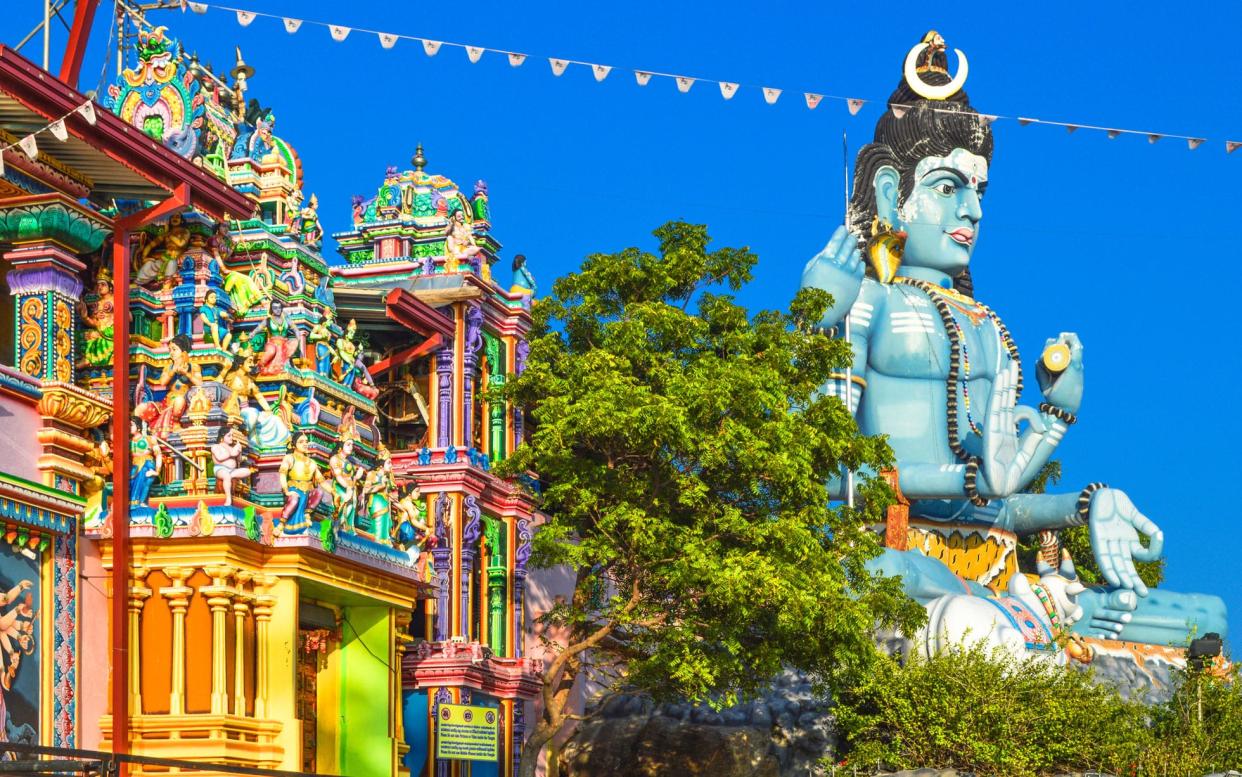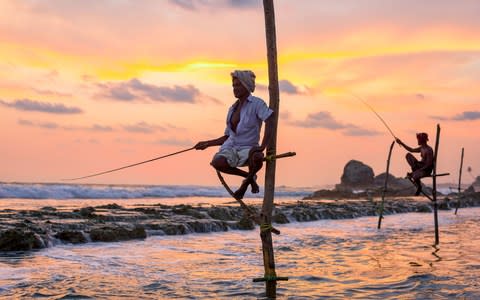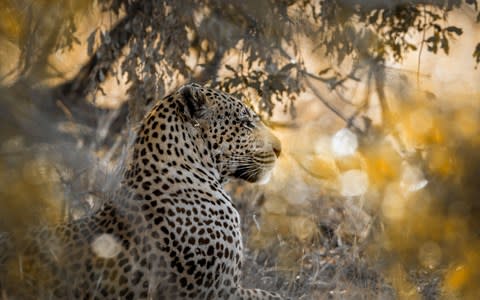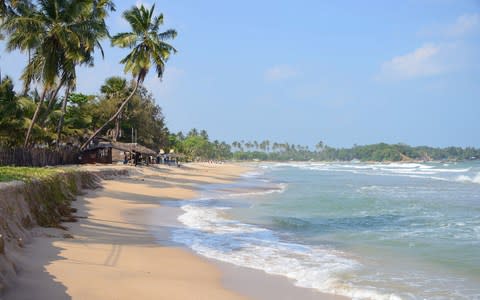Finding the real Sri Lanka in the places that were once off-limits

When I was young, my father used to talk about a magical place called Trincomalee. Just the name sounded exciting, like soft breezes blowing through palms or a chime of temple bells. My father had been there towards the end of the Second World War as a 21-year-old naval officer and even in wartime it must have seemed like paradise after the hardships of North Sea patrols and the D-Day invasion.
In 1945, Trinco’s vast natural harbour, among the largest in the world, had become a small town of naval vessels, and he recalled balmy evenings on deck with songs from Oklahoma! floating into the tropical air from a wind-up gramophone. Childhood dreams run deep and I’ve always wanted to discover Trincomalee for myself. But the town, like much of eastern Sri Lanka, was off limits from 1983 to 2009, caught up in the country’s bruising civil war between its Sinhalese, Tamil and Muslim populations.
Now, though, the east coast is opening up again. It takes time for a former war zone to get back on its feet, let alone be ready to welcome tourists – and Sri Lanka suffered another blow when a powerful tsunami struck the coast on Boxing Day 2004. But miraculously, just as so much of the world is being closed off by war or terrorism, east-coast Sri Lanka is slipping back on to the tourist map. It’s a gradual, sometimes faltering process as recent political upheavals demonstrate. But travel in the east is all the better for providing, with the odd exception, a more authentic view of the country than the tourist beaches of the south.
Perversely, we started our tour in south-west Sri Lanka, squeezing in a few days in the old port city of Galle before the west coast monsoon season kicked in. It’s an engaging place and the historic sea-facing Fort area, built by the Portuguese with some serious later bolstering by the Dutch, has retained much of its colonial charm. Narrow streets are lined with red-roofed, pillared buildings – now stylish shops selling textiles, jewellery and clothes, or organic cafés; grand houses have become chic boutique hotels. Walking along the grass-topped ramparts, among the kite fliers and boy cricketers, you look over the famous cricket ground and out to the Indian Ocean as the emerald-green sea hisses and crashes below.
But thunder was rolling over Galle, the monsoon was approaching and it was time to head east, where, this being late April, the dry season was conveniently about to begin. We took the southern coastal route, with glimpses of surf-edged bays and stilt fishermen interspersed with noisy traffic, hotels, surf lodges and shops. Taking a short detour inland to the Handunugoda Tea Estate revealed a greener, calmer world of rural lanes and giant potholes, banana groves, rice paddies, buffalo, egrets and dozens of cheerful-looking dogs, tails aloft.

The speciality at Handunugoda is white tea – the young buds of which were once picked exclusively by virgins wearing silk gloves and bearing golden scissors. Nowadays pickers are a more eclectic bunch, but they still wear gloves to pick this most rarefied and expensive of teas, with enough antioxidants to de-wrinkle a passion fruit. We tried it as the culmination of a tour of the estate – though I’m afraid to say I preferred the more plebeian Earl Grey.
After a long day on the road, we reached Sri Lanka’s wildlife hotspot, Yala National Park in the far south-east. Our hotel, Chena Huts, backed on to a wild, end-of-the-world beach, littered with boulders and smashed by thundering waves. Red and yellow lapwings flitted among the bleached driftwood, their plaintive calls echoing above the roar of the surf.
Lapwings were eclipsed on our Jeep safari the next morning by little bee eaters, swooping around us like flecks of emerald green. Crimson-backed kingfishers, hundreds of peacocks and jungle fowl, their crests shining as if plated with gold, lit up the bush. Leopards, apparently two-a-penny at Yala, proved elusive, but big sightings included elephants rooting among the lotus flowers in a water hole and a close encounter with a sloth bear – the inspiration for Rudyard Kipling’s Baloo – that demolished a termite mound and siphoned up the contents with its long tongue.

Yala has Sri Lanka’s greatest concentration of wildlife – but also of safari vehicles. We were lucky that the Chena Huts’ drivers and guides were as good at dodging the crowds as they were at spotting game. Still, there’s a lot to be said for the country’s less-lauded national parks, such as Gal Oya, our next stop, a few hours north and about 30 miles (50km) inland. It was closed to visitors for much of the war, but tourist numbers are slowly growing, thanks to ventures such as Gal Oya Lodge, a small, beautifully designed eco hotel in the jungle where you drift off to the chirrup of crickets and wake to the sound of birdsong.
Our Jeep safari, where we met not another soul, ended with a picnic and river swim in crystal clear pools among rapids and waterfalls – and just to prove that wildlife is more than the big five, our guide, who happened to be writing a thesis on the subject, pointed out myriad varieties of rainbow-coloured dragonflies.
This was the only park in Sri Lanka offering boat safaris – on vast Senanayake Samudraya lake. As we drifted quietly offshore we watched elephants bathing, a yellow-toothed mugger crocodile chasing off an intruder – and a dramatic aerial chase as a sea eagle pursued a cormorant.

Heading north up the east coast, the lush green peace of Gal Oya gave way to a new world of Tamil Sri Lanka, full of motion and colour. It was a drier, dustier and busier landscape, with brightly painted Hindu temples, rainbow-coloured lorries, women in pink and yellow saris, curly architectural details and helter-skelter striped walls. Mop-headed Palmyra palms lined the coast road, where a string of towns led to Batticaloa and, just beyond it, Passekudah – its wide bay ringed with smart hotels, making it the nearest thing this stretch of coast gets to a tourist resort.
It was a relaxing place, but rather lacking in local atmosphere. So we headed back to the bustle of Batticaloa for a fascinating cycle tour through the tree-lined backstreets and along the beachfront of nearby Muslim and Hindu coastal towns and villages. Keeping away from the main roads we stopped off at a waterside fish market, a beautifully cool and peaceful mosque, a local Hindu temple and the home of a local family who gave us one of our best meals in Sri Lanka.
North of Batticaloa the landscape flattens, and stretches of scrub are interspersed with the glistening pools of prawn farms and paddy fields, glimpses of beach or lagoon and the occasional Hindu shrine. The traffic was a terrifying free-for-all as buses and cars wove among bikes, tuk-tuks, elderly pedestrians, goats, cattle and hordes of dogs. For the hundredth time I gave thanks for our air-conditioned car and its calm and unflappable driver, Sudi; this is emphatically not a place where I’d recommend self-drive.
Then, finally, we were entering Trincomalee, a cheerfully raffish place with flashes of blue sea at the end of lanes and alleyways. It’s a mix of colonial-era villas and orange prayer flags, a very English-style esplanade housing a large Buddha statue and some pretty Hindu temples. The narrow streets in the centre of this ancient port – where Ptolemy and Marco Polo are reputed to have walked – have shop fronts hung with saris billowing like sails in the sea breeze.
But there was little sign of life in the great harbour, where just a few ships chugged across a glassy expanse. Instead, most of the residents seemed to have decamped to Swami Rock, high above the town. There, among the solid walls of Fort Frederick (yet more power play from colonial forces) cheerful crowds were chatting, relaxing and visiting the clifftop Koneswaram Kovil temple, with its sweeping views over the town and surrounding coastline.

Down below, on the outskirts of town, we stopped off at the beautifully tended war cemetery, where trees shade the graves of servicemen of many nationalities killed in the Second World War – a sobering reminder that Trincomalee wasn’t always the exotic place my father found it.
Trinco is almost the final outpost for tourists along the east coast. A string of magnificent gold-sand beaches beyond the town are backed by the laid-back village outposts of Uppuveli, Nilaveli – and finally Kuchchaveli. There, the thatched huts of lovely Jungle Beach hotel sit just above the sand, overlooking the curve of the coast as it stretches away to the north, empty and magnificent – for now.
How to do it
Experience Travel Group (020 3603 6582; experiencetravelgroup.com) offers 14 nights in Sri Lanka from £3,949pp based on two travelling together. The price includes two nights in Parrotfish Bay, two nights all-inclusive at Chena Huts, two nights full-board at Gal Oya Lodge, two nights B&B at Jungle Beach and two nights half-board at Notary’s House. Flights between Heathrow and Colombo, plus all internal transfers, are also included.

